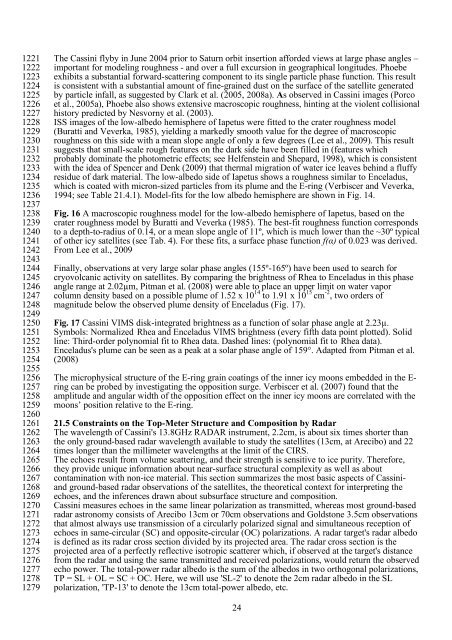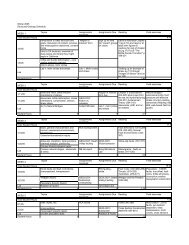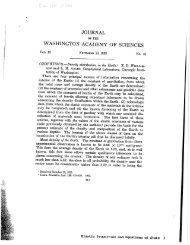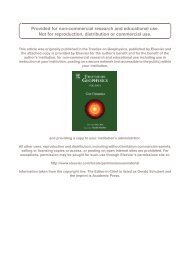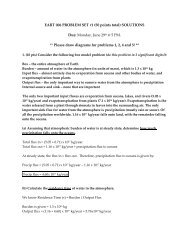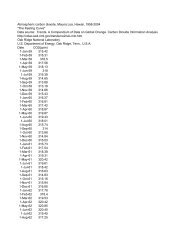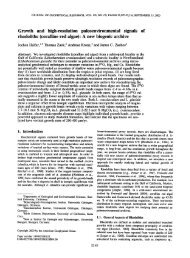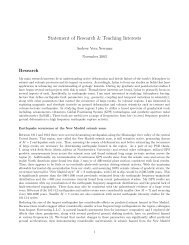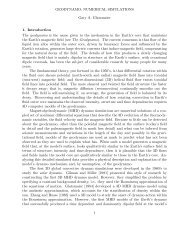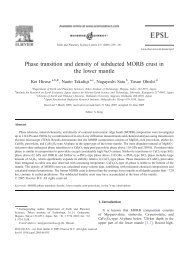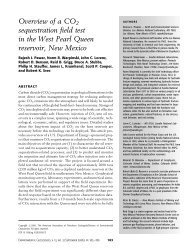Reprint - Earth & Planetary Sciences - University of California, Santa ...
Reprint - Earth & Planetary Sciences - University of California, Santa ...
Reprint - Earth & Planetary Sciences - University of California, Santa ...
You also want an ePaper? Increase the reach of your titles
YUMPU automatically turns print PDFs into web optimized ePapers that Google loves.
1221 The Cassini flyby in June 2004 prior to Saturn orbit insertion afforded views at large phase angles –<br />
1222 important for modeling roughness - and over a full excursion in geographical longitudes. Phoebe<br />
1223 exhibits a substantial forward-scattering component to its single particle phase function. This result<br />
1224 is consistent with a substantial amount <strong>of</strong> fine-grained dust on the surface <strong>of</strong> the satellite generated<br />
1225 by particle infall, as suggested by Clark et al. (2005, 2008a). As observed in Cassini images (Porco<br />
1226 et al., 2005a), Phoebe also shows extensive macroscopic roughness, hinting at the violent collisional<br />
1227 history predicted by Nesvorny et al. (2003).<br />
1228 ISS images <strong>of</strong> the low-albedo hemisphere <strong>of</strong> Iapetus were fitted to the crater roughness model<br />
1229 (Buratti and Veverka, 1985), yielding a markedly smooth value for the degree <strong>of</strong> macroscopic<br />
1230 roughness on this side with a mean slope angle <strong>of</strong> only a few degrees (Lee et al., 2009). This result<br />
1231 suggests that small-scale rough features on the dark side have been filled in (features which<br />
1232 probably dominate the photometric effects; see Helfenstein and Shepard, 1998), which is consistent<br />
1233 with the idea <strong>of</strong> Spencer and Denk (2009) that thermal migration <strong>of</strong> water ice leaves behind a fluffy<br />
1234 residue <strong>of</strong> dark material. The low-albedo side <strong>of</strong> Iapetus shows a roughness similar to Enceladus,<br />
1235 which is coated with micron-sized particles from its plume and the E-ring (Verbiscer and Veverka,<br />
1236<br />
1237<br />
1994; see Table 21.4.1). Model-fits for the low albedo hemisphere are shown in Fig. 14.<br />
1238 Fig. 16 A macroscopic roughness model for the low-albedo hemisphere <strong>of</strong> Iapetus, based on the<br />
1239 crater roughness model by Buratti and Veverka (1985). The best-fit roughness function corresponds<br />
1240 to a depth-to-radius <strong>of</strong> 0.14, or a mean slope angle <strong>of</strong> 11º, which is much lower than the ~30º typical<br />
1241<br />
1242<br />
1243<br />
<strong>of</strong> other icy satellites (see Tab. 4). For these fits, a surface phase function f(α) <strong>of</strong> 0.023 was derived.<br />
From Lee et al., 2009<br />
1244 Finally, observations at very large solar phase angles (155º-165º) have been used to search for<br />
1245 cryovolcanic activity on satellites. By comparing the brightness <strong>of</strong> Rhea to Enceladus in this phase<br />
1246 angle range at 2.02µm, Pitman et al. (2008) were able to place an upper limit on water vapor<br />
column density based on a possible plume <strong>of</strong> 1.52 x 10 14 to 1.91 x 10 15 cm -2 1247 , two orders <strong>of</strong><br />
1248<br />
1249<br />
magnitude below the observed plume density <strong>of</strong> Enceladus (Fig. 17).<br />
1250 Fig. 17 Cassini VIMS disk-integrated brightness as a function <strong>of</strong> solar phase angle at 2.23µ.<br />
1251 Symbols: Normalized Rhea and Enceladus VIMS brightness (every fifth data point plotted). Solid<br />
1252 line: Third-order polynomial fit to Rhea data. Dashed lines: (polynomial fit to Rhea data).<br />
1253 Enceladus's plume can be seen as a peak at a solar phase angle <strong>of</strong> 159°. Adapted from Pitman et al.<br />
1254<br />
1255<br />
(2008)<br />
1256 The microphysical structure <strong>of</strong> the E-ring grain coatings <strong>of</strong> the inner icy moons embedded in the E-<br />
1257 ring can be probed by investigating the opposition surge. Verbiscer et al. (2007) found that the<br />
1258 amplitude and angular width <strong>of</strong> the opposition effect on the inner icy moons are correlated with the<br />
1259<br />
1260<br />
moons’ position relative to the E-ring.<br />
1261 21.5 Constraints on the Top-Meter Structure and Composition by Radar<br />
1262 The wavelength <strong>of</strong> Cassini's 13.8GHz RADAR instrument, 2.2cm, is about six times shorter than<br />
1263<br />
1264<br />
the only ground-based radar wavelength available to study the satellites (13cm, at Arecibo) and 22<br />
times longer than the millimeter wavelengths at the limit <strong>of</strong> the CIRS.<br />
1265 The echoes result from volume scattering, and their strength is sensitive to ice purity. Therefore,<br />
1266 they provide unique information about near-surface structural complexity as well as about<br />
1267 contamination with non-ice material. This section summarizes the most basic aspects <strong>of</strong> Cassini-<br />
1268 and ground-based radar observations <strong>of</strong> the satellites, the theoretical context for interpreting the<br />
1269 echoes, and the inferences drawn about subsurface structure and composition.<br />
1270 Cassini measures echoes in the same linear polarization as transmitted, whereas most ground-based<br />
1271 radar astronomy consists <strong>of</strong> Arecibo 13cm or 70cm observations and Goldstone 3.5cm observations<br />
1272 that almost always use transmission <strong>of</strong> a circularly polarized signal and simultaneous reception <strong>of</strong><br />
1273 echoes in same-circular (SC) and opposite-circular (OC) polarizations. A radar target's radar albedo<br />
1274 is defined as its radar cross section divided by its projected area. The radar cross section is the<br />
1275 projected area <strong>of</strong> a perfectly reflective isotropic scatterer which, if observed at the target's distance<br />
1276 from the radar and using the same transmitted and received polarizations, would return the observed<br />
1277 echo power. The total-power radar albedo is the sum <strong>of</strong> the albedos in two orthogonal polarizations,<br />
1278 TP = SL + OL = SC + OC. Here, we will use 'SL-2' to denote the 2cm radar albedo in the SL<br />
1279<br />
polarization, 'TP-13' to denote the 13cm total-power albedo, etc.<br />
24


